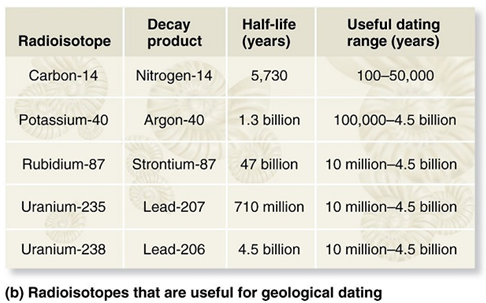A common motif found in transposons and integrases is the DDE motif. Which of the following is a true statement with regard to the DDE motif?
A. This motif refers to the three consecutive amino acids that are found in the primary sequence of transposons and integrases.
B. This motif refers to the presence of three amino acids not arranged consecutively in the proteins primary sequence but present together in the active site.
C. The DDE motif is composed of two glutamates and one aspartate.
D. Conservation of the DDE motif has not been useful in demonstrating evolutionary relatedness among transposases and integrases.
E. The DDE motif is a structural similarity but has no functional relation in transposases and integrases.
B
You might also like to view...
You uncovered a fossil that you suspect is around 100 million years old. Which of the radioisotope pairs in the table below could you eliminate as an appropriate choice for radioisotope dating the accompanying rock?

A. Potassium-40/Argon-40 (half-life = 1.3 billion years; useful dating range =100,000-4.5 billion years).
B. Rubidium-87/Strontium-87 (half-life = 47 billion years; useful dating range = 10 million-4.5 billion years).
C. Uranium-235/Lead-207 (half-life = 710 million years; useful dating range = 10 million-4.5 billion years).
D. Carbon-14/Nitrogen-14 (half-life = 5,730 years; useful dating range = 100-50,000 years).
E. Uranium-238/Lead-206 (half-life 4.5 billion years; useful dating range = 10 million-4.5 billion years).
Which of the following is an adaptation that enhances the uptake of water and minerals by roots?
A) mycorrhizae B) cavitation C) active uptake by vessel elements D) rhythmic contractions by cortical cells E) pumping through plasmodesmata
Which of the following pathogenic characteristics would best allow Brucella organisms to produce a chronic infection in a host?
a. weakened inflammatory response b. resistance to complement c. resistance to antibiotics d. sequestering of organism within the endoplasmic reticulum
A woman comes to the emergency department with fever and vomiting. She soon develops a red rash all over her body, and her blood pressure begins to drop. What is a likely diagnosis?
A. erysipelas B. endocarditis C. scarlet fever D. toxic shock syndrome E. staphylococcal food poisoning